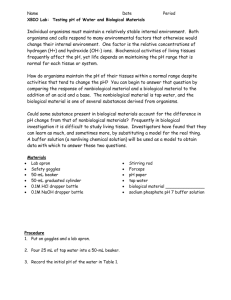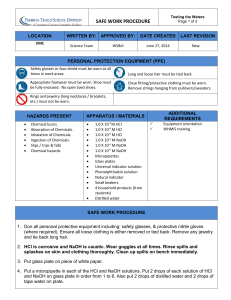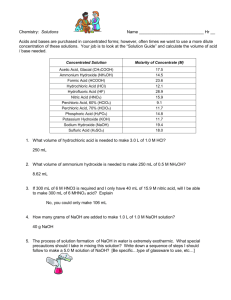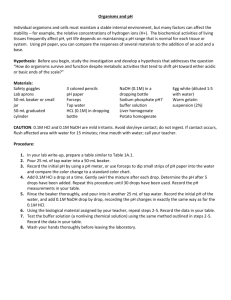Chemical Kinetics Computer Simulation 1
advertisement
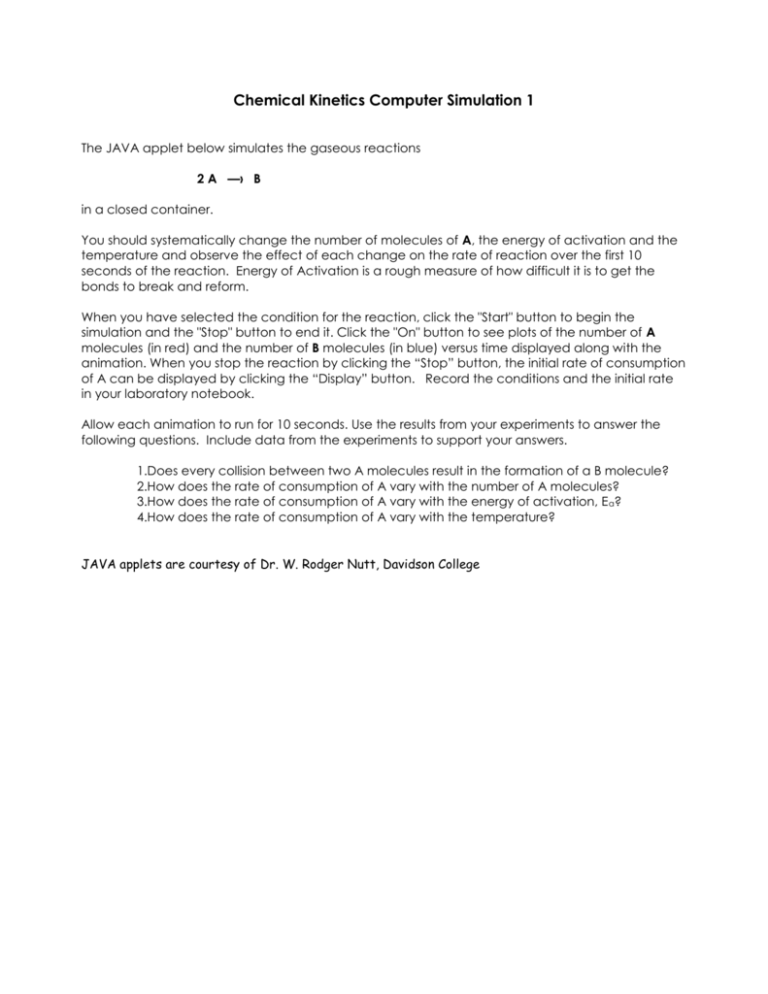
Chemical Kinetics Computer Simulation 1 The JAVA applet below simulates the gaseous reactions 2 A —› B in a closed container. You should systematically change the number of molecules of A, the energy of activation and the temperature and observe the effect of each change on the rate of reaction over the first 10 seconds of the reaction. Energy of Activation is a rough measure of how difficult it is to get the bonds to break and reform. When you have selected the condition for the reaction, click the "Start" button to begin the simulation and the "Stop" button to end it. Click the "On" button to see plots of the number of A molecules (in red) and the number of B molecules (in blue) versus time displayed along with the animation. When you stop the reaction by clicking the “Stop” button, the initial rate of consumption of A can be displayed by clicking the “Display” button. Record the conditions and the initial rate in your laboratory notebook. Allow each animation to run for 10 seconds. Use the results from your experiments to answer the following questions. Include data from the experiments to support your answers. 1.Does every collision between two A molecules result in the formation of a B molecule? 2.How does the rate of consumption of A vary with the number of A molecules? 3.How does the rate of consumption of A vary with the energy of activation, E a? 4.How does the rate of consumption of A vary with the temperature? JAVA applets are courtesy of Dr. W. Rodger Nutt, Davidson College Chemical Kinetics Computer Simulation 2 The JAVA applet below plots the molarities of the reactant A and product B over time as the reaction 2 A —› B proceeds to completion. Design experiments to answer each question by changing the energy of activation, the temperature, and the concentration of A (from 0.0 M to 5.0 M) and observing the effect of each change on the rate of reaction. Energy of Activation is a rough measure of how difficult it is to get the bonds to break and reform. You may have to click “Enter” a couple of times to get the entire plot to print. Avoid scrolling up and down the page since this seems to interrupt the plot. Sometimes the data and the rates overlap on the screen and become hard to read. Fix this by changing the variables. Allow each animation to run until the rates are shown. The rate of disappearance of A (shown in red ) is calculated for time = 0, for time = 4 s, and for time = 15 s. The rate of disappearance of B (shown in blue) is calculated for time = 4. Use the results from your experiments to answer the following questions. Include data from the experiments to support your answers. 1.How does the initial rate of consumption of A change with a change in the initial molarity of A? 2.How and why does the rate of consumption of A change with time? 3.Is the rate of formation of B at 4 seconds equal to the rate of consumption of A at 4 seconds? 4.How does the initial rate of consumption of A change with a change in the energy of activation, Ea? 5.How does the initial rate of consumption of A change with a change in the temperature? JAVA applets are courtesy of Dr. W. Rodger Nutt, Davidson College Effect of Concentration on Reaction Rate By Paul Hobe Woodrow Wilson Leadership Program in Chemistry PURPOSE This experiment illustrates the effect of concentration on reaction rate. HAZARDS Concentrated solutions of NaOH and HCl will burn skin and damage clothing. Fumes from acid may be caustic and/or irritating; carry out the reactions in a well-ventilated room (hood, if available). Do not mix the NaOH and HCl solutions; splattering may occur. Some splattering may occur near the end of the reaction of the NaOH or HCl with the aluminum; use care. Wipe up any splatters with wet paper towels. Goggles must be worn throughout the experiment. PROCEDURE 1. Place a 18 x 150 mm test tube in a clamp and attach to a ring stand or pole. Cut a 2 inch by 2 inch piece of aluminum foil. Gently lay the piece of foil across the test tube and with the bottom of a similar-sized test tube force the foil into the tube to form a basin-like depression. 2. Carefully add 10 drops of the concentrated NaOH solution to the depression in the foil. Begin timing when the first drop on NaOH hits the foil. 3. End the timing when there is evidence that a hole has formed in the foil. The solution may simply drop into the tube or a small hole may form with a drop of solution visible below the hole. 4. With forceps, carefully pick up the foil and rinse with water. Place used foil in a trash can. 5. Repeat using a new piece of foil, but in this trial, place 2 drops of water on the foil and then add 8 drops of the NaOH solution. Start timing when the first drop of NaOH solution is added. 6. Continue using new pieces of foil with various dilutions of NaOH as listed in the table below. When you finish the last trial, rinse out the test tube and return it to the stockpile. Drops of Water Drops of NaOH 0 10 2 8 4 6 6 4 8 2 Time 7. Repeat the experiment using HCl solution in place of the NaOH solution. 8. Prepare three graphs. The first graph is of time on the vertical axis and number of drops of NaOH on the horizontal axis. The second graph is of time on the vertical axis and the number of drops of HCl on the horizontal axis. The third graph has both smoothed lines on the same graph. Use the EXCEL spreadsheet program to make two graphs. Make XY scatter graphs with the datapoints connected with smoothed lines. Attach the graphs to your laboratory notebook. See the EXCEL handout for help. 9. Describe the effect of the concentrations of NaOH and HCl on the rate of the reaction. Suggest a reason for why the two graphs might differ. DISCUSSION Drano and other solid drain cleaners usually consist of lye, NaOH, and a small amount of metallic aluminum. The aluminum reacts with the lye solution to form hydrogen gas. The bubbling of the gas provides a physical action that helps unclog a drain. The reaction is: 2 Al(s) + 2 OH-(aq) + 6 H2O(l) 2 Al(OH)4-(aq) + 3 H2(g) Aluminum also reacts with HCl solution to form hydrogen gas according to the following equation. 2 Al(s) + 6 H+(aq) 2 Al3+(aq) + 3 H2(g) The effects of concentration for NaOH and HCl are different because of differences in the activities of the two solutions. THE EFFECT OF TEMPERATURE ON THE RATE OF A REACTION By Pam Mork PURPOSE The purpose of this experiment is to show the effect of temperature on the rate of a chemical reaction. PROCEDURE 1. Fill each of the 50 mL beakers with 50 mL of water at three different temperatures. Use cold water from a refrigerated water fountain or the cold water tap (if significantly below room temperature), room temperature water, and water from the hot water tap. Record the temperature of each water sample. 2. Place one small scoop of powder mixture in each 250 mL beaker. Try to make the powder mixture scoops the same size. 3. Pour the hot water into the beaker containing the powder mixture and swirl the contents. Determine how long it takes for the violent evolution of bubbles to cease in each beaker. 4. Repeat for the other two temperatures of water. 5. Describe the effect of the temperature of the reaction on the rate of the reaction. DISPOSAL Pour solutions down the drain. DISCUSSION The powder mixture was a mixture of sodium bicarbonate and citric acid. The following is the net ionic equation for the reaction that occurs. 3HCO3- (aq) + H3C6H5O7 (aq) ----> 3H2O (l) + 3CO2 (g) + C6H5O7 3- (aq) Increasing the temperature of the water increases the rate of the reaction because at higher temperatures a greater number of collisions involve sufficient energy to overcome the activation energy barrier for the reaction. EFFECT OF SURFACE AREA ON THE RATE OF A HETEROGENEOUS REACTION by Patti Ruff, Bill Vitori, Irene Walsh, Doug Wilbur, and Joe Don Wilkins Woodrow Wilson Leadership Program in Chemistry PURPOSE The objective of this demonstration is to illustrate the effect of increasing surface area upon the rate of reaction in a heterogeneous system. HAZARDS Use caution in Part B where a large flame is produced. Goggles must be worn while doing the demonstration. This demonstration must be done in a hood. PROCEDURE Part A: 1. Place a small scoop of flour onto a watch glass and light it with the Bunsen burner. It make take quite some time to ignite the flour. 2. Note the rate of burning. 3. Unburned flour should be placed in the trash can. Part B: 1. Attach a 2-foot piece of rubber tubing to the bottom of a small glass funnel and support the funnel in the ringstand set-up. 2. While pinching the rubber tubing closed at the base of the funnel, place a small scoop of flour into the funnel. 3. Place the lit Bunsen Burner next to the ring stand. Release the rubber tubing and pull the window sash of the hood down low so that only the tubing extends out of the hood. Blow sharply through the rubber tubing. 4. Note the rate of burning. 5. Discuss the difference in the rate of burning for the two flour samples. DISCUSSION In Part A, it takes some time to ignite the flour. When it finally ignites, it burns very slowly. This is because the surface area of the solid exposed to the oxygen in this heterogeneous system is relatively small. In Part B, the flour ignites with a flash, producing a flame rising above the funnel because, by dispersing the flour, the surface area of the solid exposed to the oxygen is greatly increased. The greatly increased rate of burning is why grain elevators, saw mills, and coal mines can be such dangerous places. These areas contain finely divided combustible materials. On the other hand, a lumber yard or a bag of charcoal is not particularly hazardous because the surface area of a piece of lumber or a charcoal briquette is so much smaller. REFERENCES Cotton, F.A., Darlington, C.L., and Lynch, L.D., Teacher's Guide to Chemistry: An Investigative Approach, Houghton Mifflin Co., Boston, 1980. This work describes a similar demonstration. THE EFFECT OF A CATALYST ON THE RATE OF A REACTION by Patti Ruff, Bill Vitori, Irene Walsh, Doug Wilbur and Joe Don Wilkins Woodrow Wilson Leadership Program in Chemistry PURPOSE The purpose of this experiment is to show the effect of a catalyst on the rate of a reaction. HAZARDS Caution should be used in handling hydrogen peroxide solution and manganese dioxide; both are caustic. Wear goggles throughout preparation and demonstration. PROCEDURE 1. Add 10 mL of the hydrogen peroxide solution to a 100 mL beaker. 2. Add a small squirt of liquid detergent to each beaker. Mix and observe; note the amount of bubbles being formed. 3. Add a few grains of manganese dioxide to the beaker. Compare to the behavior of the mixture without the manganese dioxide. 4. Discuss the effect of a catalyst on the rate of the reaction. 5. Pour the remains down the drain and flush the drain with lots of water. DISCUSSION A catalyst is a substance that is added to a reaction to increase the reaction rate. The catalyst allows the reaction to proceed by an alternate reaction mechanism with a lower activation energy. A catalyst is not consumed in a chemical reaction. The reaction for the decomposition of hydrogen peroxide is: 2 H2O2(aq) 2 H2O(l) + O2(g) This reaction normally proceeds very slowly. When the catalyst, manganese dioxide, is added, the rate of the reaction increases appreciably; this can be seen by the large volume of foam that is generated as the oxygen gas bubbles through the detergent solution. Little, if any, foam forms without the catalyst. The foam is gray in color because of entrapped, black manganese dioxide. REFERENCE Summerlin, L.R. and Ealy, J.L., Jr., Chemical Demonstrations - A Sourcebook for Teachers, American Chemical Society, Washington, DC, 1985, p. 71. Describes a similar demonstration using KI as the catalyst. EXCEL Handout for the Qualitative Kinetics Experiments Open the EXCEL program and enter three columns of data: one for the number of drops used, one for how long it took the NaOH to react, and one for how long it took for the HCl to react. Label each column clearly. You should consult the handout from first semester if you don’t remember how to do this or if you don’t remember how to use the chart wizard. Highlight the data in the first two columns and use the chart wizard to construct an XY scatter graph where the datapoints are connected by a smoothed line. Label all of the parts of the graph and save it as a “new sheet” in fourth step of the chart wizard. Highlight the data in column one and column three and create a second graph. Remember to highlight just the data. If you highlight the column heading, the program can’t create graphs for you! Finally, create the third graph that shows both lines on the same graph. This kind of graph is the best way to compare the rates of the two reactions. Start by highlighting the data in the first two columns. Use the chart wizard to select an XY scatter graph with smoothed datapoint lines like you did for the first two graphs. In step 2 of the chart wizard, you should see the first line. Click the tab on this screen labeled “Series.” You need to enter the values on the X-axis and the values on the Y-axis for the second line now. Click the “Add” button. Now, click the chart symbol on the far right side of the box for the X values and move back to the data sheet to highlight the x-values. These will be the same values as you used for the first line. Press the “Enter” key to enter these values. Next, click the chart symbol on the far right side of the box for the Y values and move back to the data sheet to highlight the data in the third column. Press the “Enter” key to enter these values. You should see two smoothed lines on the graph now. Proceed on to steps 3 and 4 of the chart wizard and save the graph as a new sheet. Print the three graphs as well as the data in the three columns. Attach all of them into your laboratory notebook securely. Library Project for the Kinetics Unit Find a recent article (published since 1998) in a chemical journal that reports the results of a kinetics experiment. You can look through the table of contents of these major journals to begin your search. All of these journals are available in the library. Journal of the American Chemical Society Journal of Organic Chemistry Analytical Chemistry Inorganic Chemistry Journal of Physical Chemistry You must find an article that no one else in chemistry 128 has found. If you find a duplicate, we will notify you. Make two copies of the article. Turn one copy of the article plus this completed form into your laboratory instructor at the next laboratory meeting. Keep the second copy for future assignments. Name: _______________________ Instructor Name: _______________ Title of Journal Article: Author(s) of Journal Article: Full Reference of Journal Article: Equation of the Chemical Reaction Under Study: Day of Lab Meeting: _______________ Time of Lab Meeting: _________




